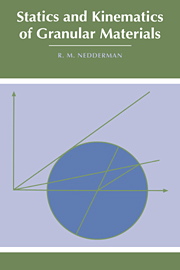Book contents
- Frontmatter
- Contents
- Notation
- 1 Introduction
- 2 The analysis of stress and strain rate
- 3 The ideal Coulomb material
- 4 Coulomb's method of wedges
- 5 The method of differential slices
- 6 Determination of physical properties
- 7 Exact stress analyses
- 8 Velocity distributions
- 9 The Conical yield function
- 10 The prediction of mass flow rate
- Set problems – chapters 2–10
- Appendices
- References and bibliography
- Index
5 - The method of differential slices
Published online by Cambridge University Press: 28 October 2009
- Frontmatter
- Contents
- Notation
- 1 Introduction
- 2 The analysis of stress and strain rate
- 3 The ideal Coulomb material
- 4 Coulomb's method of wedges
- 5 The method of differential slices
- 6 Determination of physical properties
- 7 Exact stress analyses
- 8 Velocity distributions
- 9 The Conical yield function
- 10 The prediction of mass flow rate
- Set problems – chapters 2–10
- Appendices
- References and bibliography
- Index
Summary
Introduction
The Method of Differential Slices is the name given by Hancock (1970) to a series of approximate analyses based on a method introduced by Janssen in 1895. The method has, however, been considerably extended since that time. Commercially these analyses are perhaps the most important in this book since they form the basis of the recommended procedures in most, if not all, of the national codes of practice for bunker design. The original version of the analysis, as presented by Janssen, is approximate and most design manuals present a set of empirically derived correction factors for use in conjunction with the predictions. More fundamental texts such as Walker (1966), however, attempt to correct the errors introduced by Janssen's approximations on a more rational basis. The purpose of this chapter is to outline Janssen's original method, to assess its accuracy and to describe the improvements and extensions that have been introduced subsequently.
In §5.2 we will outline the basic method for a cylindrical bunker and in §5.3 to §5.7 we will describe the improvements that can be made by more careful analysis. The method is extended to conical and wedge-shaped hoppers in §5.8 and Walters' analysis for the ‘switch stress’ is given in §5.9. Finally, in §5.10 we compare Janssen's analysis with the related analyses of Enstad and Reimbert.
Janssen's original analysis
Janssen's original analysis is best illustrated by considering the stress distribution in a cylindrical bunker containing a cohesionless granular material as illustrated in figure 5.1.
- Type
- Chapter
- Information
- Statics and Kinematics of Granular Materials , pp. 84 - 126Publisher: Cambridge University PressPrint publication year: 1992
- 2
- Cited by



